The use of mint color in the interior

So you want to come home from work, relax, feel at home, enjoy the tranquility ... It is unlikely that bright flashy colors and all kinds of accents in the interior will contribute to this. But what, then, to choose a shade so that the house is calm and at the same time fresh, as well as light at any time of the day?
At first glance, this seems like a very difficult choice. But there is a way out. The mint palette is a great solution in the interior. It is suitable for placing accents, and as a primary or secondary color for any room. Let's take a closer look at all the advantages of this color and the rules for its use.



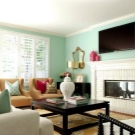


Peculiarities
The mint color is very calm. However, this color does not quite live up to its name - unlike mint leaves, which have a more herbaceous shade, it is a mixture of green and blue, slightly diluted with white. Shades of mint are used to decorate both public places and living quarters.
As mentioned earlier, the mint color has a beneficial effect on the psyche: soothes, refreshes and tune in to work, allows you to collect your thoughts. It does not tire the eyes in any quantity. Therefore, this paint is suitable for the design of any room, of course, with a combination of different colors and details.
The mint color creates a cool feeling, so it can be applied in a brightly lit room. It goes well with other tones, creating unique compositions.

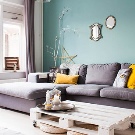




Shades
There are many shades of this color: from light blue to bright turquoise. However, there are four main shades of mint:
- menthol;
- light turquoise;
- pistachio;
- sea wave.
It can be argued that the mint color is at the border of warm and cold colors. It is enough just to add another shade to it, and it will change beyond recognition: for example, if you add yellow, then it will acquire softness and warmth, and if blue, then the color will turn out to be fresher and colder.




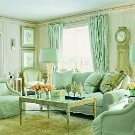

Let's take a short look at each shade.
- Menthol is a color that literally exudes coolness. He will give the room freshness, lightness, and also visually expand the room.


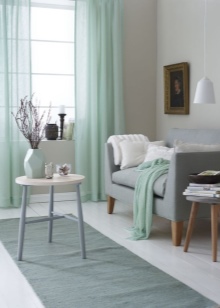
- Light turquoise is a warmer shade of mint, it is a spring, light and gentle tone that relaxes and helps to relax.



- Pistachio - close to green. Unlike previous shades, it does not have such coldness, but, on the contrary, radiates warmth, energizes and positively.


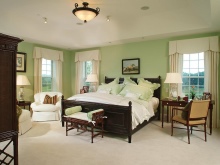
- The aqua color reminds of a warm azure sea, but at the same time, in combination with other shades, it becomes colder.
Depending on its concentration, one close to turquoise can exhibit calming properties, and a brighter one, on the contrary, induces action.



Combination with other colors
Combining mint with other shades changes its properties and qualities. One of the most advantageous combinations is a tandem of lavender and mint. Since lavender also gets its name from the flower, its combination with mint will look natural and organic. The lavender-like lilac also pairs well with it, creating some sophisticated note.
Combining white with this color looks very fresh, but you should not overdo it so as not to get the effect of hospital sterility. If you successfully combine these two colors, you will be able to visually expand the room. Here's a good example of a design.



Not a very good combination of mint with blue or green, as they are very similar. But if you choose menthol or pistachio as an accent, you get a very interesting design solution. Fuchsia or coral is combined with blue-green, if you make the latter a light background. A mix of peach with this color is also appropriate - this combination will give your room lightness and comfort.
If you want to make a calm rest room, then a combination of gray with menthol or light turquoise is perfect for this. You can paint one wall in a mint color, or make it the backdrop for gray, white, metal, and graphite pieces. You can also make the room in white and gray tones, adding details in mint shades.



One cannot but pay attention to the union of two natural colors - brown and mint. In this case, brown serves as a frame for menthol and emphasizes its freshness and calmness, adding coziness. Mint yellow is a rather bold combination, since at first glance these are completely incompatible shades. With a competent placement of accents, such a tandem will turn out to be quite harmonious: yellow warms, and mint, on the contrary, cools.
The combination of mint and beige is the most comfortable, homely and calm. Typically, such an interior is complemented by black and white details. Black with mint is a trendy combination.
With this solution, your room will look simple and casual, but at the same time stylish.

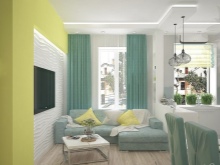

Room design options
Many people wonder how to equip a room in this color: what combinations are suitable for different rooms, what details should be done in mint color, how to properly decorate the walls, floor and ceiling and how to place accents correctly. Let's try to understand these issues by considering the design options for each room separately.




Hallway
It is this room that forms the first impression of your home. Therefore, it is so important to take care of the correct design of this room.
It is known that such auxiliary rooms usually do not have windows, so the mint color will perfectly fit into the interior and make it lighter. Also, the combination of menthol with white will help to visually expand the room. A snow-white ceiling, light mint walls and a dark floor - and your room will visually become larger.


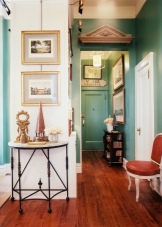
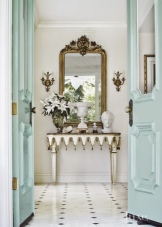
Kitchen
This is the place where every hostess spends most of the day. Therefore, it is extremely important to properly equip it so that it is pleasant and comfortable to be in it. The mint color is versatile, and therefore suitable for the kitchen. Although very daring for kitchen design, it is quite easy to work with. Most often, the facades of the kitchen are menthol or light turquoise. Such furniture creates a relaxed atmosphere, it can be placed on a metal or graphite background.
If you want a kitchen in bright fruit colors, then a combination of a mint shade with red, yellow and orange is perfect for you (the latter color is notable for increasing appetite and cheering up). This combination is a modern ultra-fashionable solution. The interior of a small kitchen needs to be done in white and light mint colors. The elements of the tree also serve for this purpose.


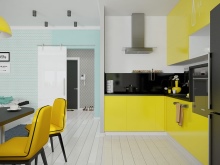
If you want to make a mint color as a background, then you can dilute it with catchy details: curly plastic, metal, wooden and glass parts, or, conversely, arrange mint details in the kitchen in the form of panels, chairs, towels, paintings, and so on.
To create a comfortable kitchen in warm natural colors, it is enough to make the background beige or sandy with mint; indoor flowers will perfectly fit into this composition.
You can also add details in lavender, pink or lilac shades.



Bathroom
In the bathroom, the entire mint palette can be safely used as the main color. After all, it is in this room that the marine style looks most natural. The menthol shade can be used for the background.You can also add light turquoise details to it: bathroom curtains, towels, blinds, and so on. The use of glossy and reflective surfaces will bring freshness and visually expand the room.
An interesting and bold bathroom solution - mint tiles on the walls and on the floor. On walls, you can use panels on the bottom of the wall and tiles on the top. It is important to remember that no more than three shades can be used in one room, so as not to overload the composition. If you want to use the tiles only on the floor, then the walls can be pasted over with non-woven wallpaper or painted with waterproof mint emulsion paint.


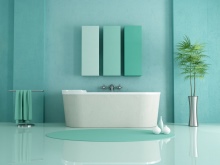
Living room
The living room is the room into which we bring guests. Of course, it is important that our friends and relatives feel comfortable and cozy to spend time in it. Mint color is an excellent choice for decorating such a room, because this color is very cozy and calm, and a room made in this color is spacious and light. If your choice is mint-colored walls, then the presence of paintings depicting nature in such a room will create a joyful and spring mood. And furniture in pastel and light shades will soften the eccentricity of the design.
Well, if the walls in the living room are in contrasting colors or white, then furniture in rich mint shades will add bright notes. Light turquoise curtains are also appropriate in this case. Beige or cream decor will bring warmth to the hall. If you want to create a dynamic composition, then place dark furniture against the background of mint walls.



Bedroom
As you know, this room is designed for relaxation and privacy. The bedroom can be designed so that it is comfortable for you, and not for someone else. That is, the interior of this room completely depends on your wishes. It is best to use mint shades on curtains, bedding and pillows. The use of menthol as a background is also allowed. In this case, adding wood details is encouraged to balance the palette.
To create a delicate bedroom interior, you need a combination of white, beige, cream, light pink, sand and peach with mint. To add accents, just go for brighter colors.



Children
The mint color is neutral and has no gender reference, it is perfect for a room for both a boy and a girl. It is enough to dilute the light turquoise tone with pink, and a palette for a girly room will be released. A mint background, surfaces of delicate pink or crimson color, bright purple pillows - and the nursery is ready. Also, a mint-colored or aquamarine carpet will be appropriate in it. To make a bedroom for a boy, you can use a combination of mint with bright blue or blue.
However, it is important to remember that blue tones should be carefully combined with minty shades so that the palette does not mix.



Examples in the interior
As we have seen, the mint color in the interior is universal. It is suitable for any room and room, the main thing is to correctly place accents, depending on what you are trying to highlight and how you want to see the room - light or dark.
And in conclusion, some interesting ideas for the interior.
- Mint brown kitsch style living room.

- Fresh kitchen in a minimalist style.

- A pistachio bedroom reminiscent of summer.
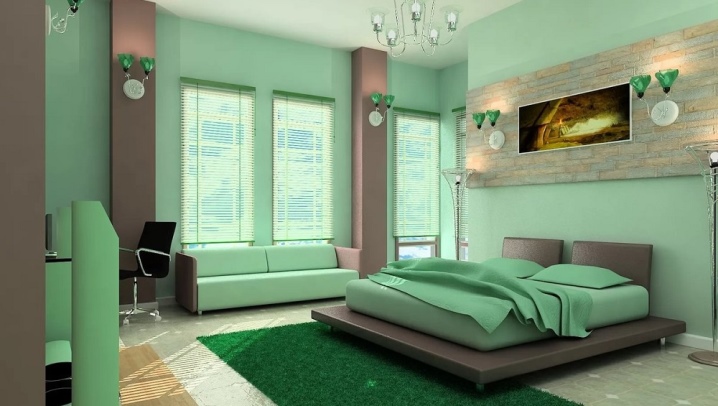
- A corridor that visually appears wider due to the combination of white, mint and wood elements.
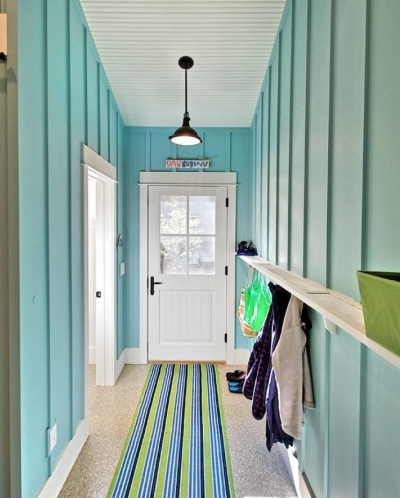
- A great example of how to visually enlarge a small kitchen.

- Very cozy little bathroom in mint colors.














The comment was sent successfully.